Cats, like all animals, are susceptible to eye disease. Eye disease in cats can be both acquired and congenital. For the quickest recovery of your pet, you need to diagnose the disease as early as possible and begin treatment.
Therefore, when the following symptoms appear, it is advisable to immediately contact the veterinarian:
- Redness, itching and lacrimation;
- Excretion of pus;
- Increased body temperature;
- Vomiting, diarrhea, etc.
Let’s look at the most common eye diseases in cats:
Epiphora in cats
The symptom of this disease is pulsive lacrimation.
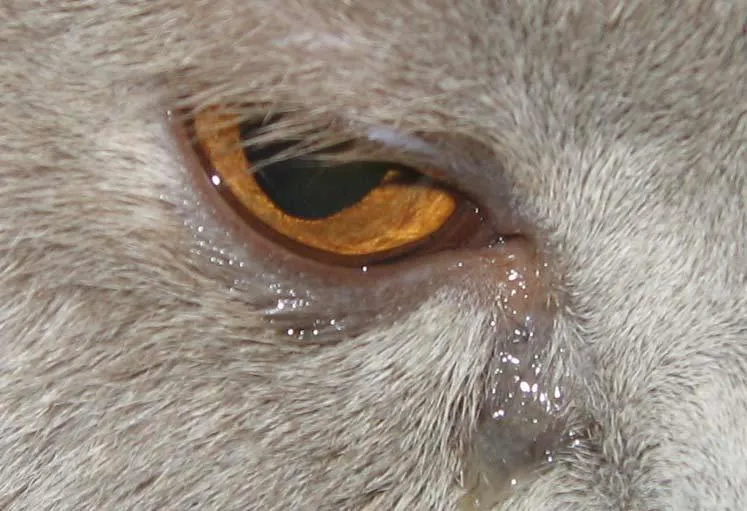
Causes of epiphora in cats
-
Increased lacrimation due to irritation of the eye structure:
- Entry of foreign bodies;
- Conjunctivitis;
- Everted eyelids in the inner corner of the eye;
- Improper growth of the eyelashes toward the eyeball, which causes irritation to the cornea;
- Underdevelopment of the eyelids, or their congenital absence, etc.
-
Improper patency of the lacrimal passages:
- Lacrimal point deficiency. This is mostly a congenital abnormality;
- Inflammation of the lacrimal sac. This is an acquired defect, due to diseases such as sinusitis, rhinitis, or ingestion of a foreign object.
-
Defect of the lacrimal ducts:
- The lower eyelid is very tight against the eyeball, small tear volume in breeds with large eyes (Persian);
- Blockage of the lower lacrimal point (all breeds with a flattened nose, short muzzle, and round head). This is due to a twist in the inner part of the lower eyelid;
- The small size of the lacrimal point;
- The hair, which is on the inner lacrimal tubercle, absorbs the tear. Breeds of cats with long hair are prone to this.
Diagnosis of epiphora in cats
It is necessary to distinguish between lacrimation and purulent discharge from the eyes. If irritation occurs, redness of the eye is noticeable. If a foreign body enters, pain appears. If the cause is rhinitis or sinusitis, the lacrimation is accompanied by sneezing and nasal discharge. An MRI or CT scan can be done.
Treatment of epiphora in cats
Treatment varies, depending on the cause of the disease. If a foreign object is caught, it is removed. In the absence of a tear point it is necessary to resort to surgical intervention. With inflammatory diseases prescribe antibiotic therapy. There are many causes of epiphora, so there are many ways to treat it, too. Entrust your pet to a professional, because first you need to identify the cause, so treatment can be effective and not harmful to the animal!
Glaucoma in cats
A disease that is accompanied by an increase in intraocular pressure and enlargement of the eyeball.
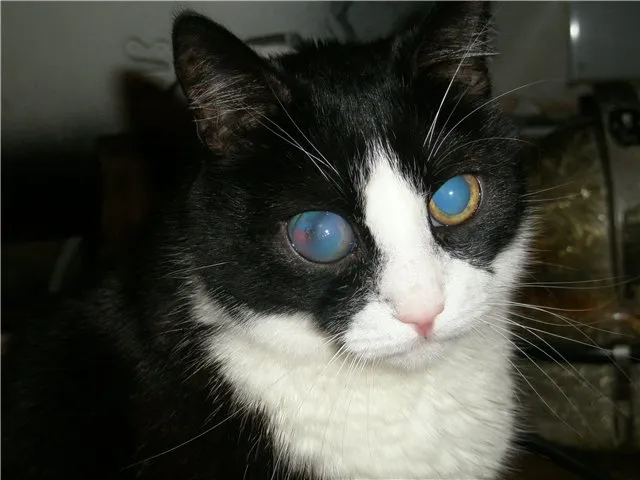
Symptoms of glaucoma in cats
Symptoms are visible to the “naked” eye. There is an enlargement of the pupil, reflection of the ocular fundus, protrusion of the cornea, which becomes no longer mirror-like. If this disease is not treated in time, the animal may permanently lose its vision, as the retina dies out.
Treatment of glaucoma in cats
Conducted only with drugs that reduce intraocular pressure. An ointment is prescribed to restore the cornea and prevent it from drying out. To prevent this disease in your pet, you must carefully remove secretions from the eyes with a tampon, pre-moistened in a special lotion for animals. Lotions are available for both external use and for treating the cornea itself, so you should read the instructions for use carefully.
Blepharitis in cats
Inflammation of the eyelids, which causes thickening and redness of the eyelid edges.
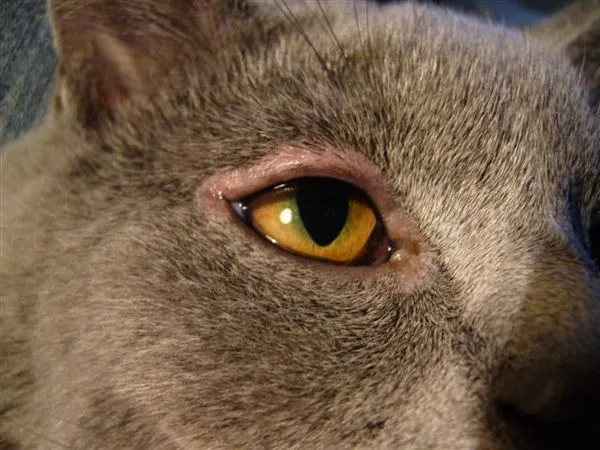
Blepharitis comes in several types: simple, meibomian, and ulcerative.
Let’s take a closer look at each type. Simple blepharitis. In this disease there is an overflow of blood vessels (hyperemia) and thickening of the eyelid margins. Scales of grayish-white color appear at the base of the eyelashes.
If the margins of the eyelids swell and their surface is covered with pus and ulcerous surface appears under it - it is no longer a simple, but ulcerous blepharitis. The main sign is lacrimation and itching of the eyelids. If the inflammation affects the roots of the eyelashes, they fall out. The eyelids may droop or pop out. Ulcerative blepharitis is treated by removing the dead tissue, first softening the surface of the eyelids, best done with fish oil. Then the edges are cauterized with a special disinfectant and washed with water or saline solution. Then, within a week, an ointment containing antibiotics is applied to the affected areas of the eyelids.
Another type of blepharitis is meibomian. It occurs due to hypersecretion of meibomian glands (named after the doctor Heinrich Meibon). Signs are hyperemia and severe thickening of the eyelid margins. Pathogenic microorganisms getting into these glands cause purulent inflammation of the eyelids. Zelenka and yellow mercury ointment are used to treat this inflammation.
Before you begin treatment, you should show your beloved pet to a veterinarian who will be able to select the right treatment for your pet. It is not advisable to use medications without the approval of a specialist, because improper treatment can make the situation worse.
Conjunctivitis in cats
Conjunctivitis is an infection and irritation of the outer transparent mucous membrane that covers the eyeball and the inner surface of the eyelids. It is considered the most common eye disease in cats. There are many causes of this disease.

The most common ones are:
- Mechanical exposure. Since our beloved cats and felines are quite fidgety, they often expose themselves to injury (especially if the cat likes to walk outside). The eyes can be susceptible to injury or ingestion of foreign bodies;
- Infections (calcivirus, toxoplasmosis);
- Chemical irritants (alkali, medications, lime, acids);
- Avitaminosis (vitamin A increases the protective function of the mucous membrane);
- Allergies (mainly to plants and pollen).
Forms of conjunctivitis in cats
Cat conjunctivitis can be acute or chronic. Acute inflammation causes partial or even complete closure of the eye, and a heavy discharge from the eye. In the chronic form, there may be no discharge, but the eyelids will wilt.
Purulent conjunctivitis occurs as an inflammatory process caused by streptococci and staphylococci. Once in the conjunctiva, the microbes begin to multiply in an environment that is favorable for them, causing purulent discharge. Compared to catarrhal conjunctivitis, purulent conjunctivitis has more discharge.
Phlegmonic conjunctivitis is considered the most difficult because it affects the entire conjunctiva and subepithelial layer. A large number of lymph follicles form in the conjunctiva of the third eyelid, which affects the entire surface of the eyelid. This form of conjunctivitis occurs chronically. The conjunctiva is very swollen and may protrude from the eye socket.
Allergic conjunctivitis Discharges from the eyes are clear and watery. There is redness and swelling.
You should contact your veterinarian if you experience the following symptoms: red eyes, tearfulness, frequent eye blinking, your pet constantly scratching his eyes, eyelids half-open, thick, green-gray discharge in the corners of the eyes.
Treatment of conjunctivitis in cats
Depending on the type of disease, different medications are used for treatment. In the treatment of conjunctivitis caused by infections, antibiotics or solutions with antibacterial effect are used. If foreign bodies are ingested, drops and ointments are used.
In order to ensure that your pet does not have to experience this unpleasant disease, it is necessary to monitor the cleanliness of his eyes, you need to wipe them daily with a solution of furacilin. It is also necessary to vaccinate them.
And remember! The sooner you contact a specialist and start treatment, the faster the chance to cure and prevent complications.
Keratitis in cats
Keratitis is an inflammation of the cornea, which causes it to become cloudy.
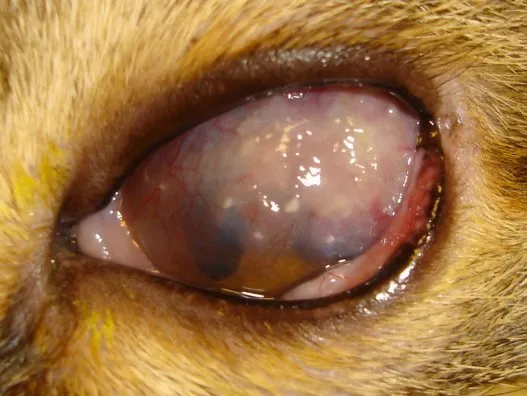
There are several types: superficial, deep, purulent, and non-purulent. Superficial keratitis affects the outer epithelial layer, deep affects the corneal parenchyma.
Signs of keratitis: clouding of the eye, redness, lacrimation, squinting of the eye, festering, photophobia.
The causative agents of keratitis are herpes simplex viruses, which are transmitted through dirty objects. There is also bacterial keratitis. Its causative agents are pseudomonas bacillus, coccus, gram-negative and gram-positive bacteria.
Treatment of keratitis in cats
Treatment should be started after determining the cause of the disease. Bacterial keratitis is treated with drugs containing antibiotics.
If treatment is started in time and effectively, the disease passes and the transparency of the cornea can be restored. Otherwise, multiple complications may occur.
Dacryocystitis in cats
Dacryocystitis (inflammation of the lacrimal sac) - in most cases occurs due to the transition of the inflammatory process from the conjunctiva, the lacrimal duct or the nose.
So how to recognize this disease. The mucosa of the lacrimal sac becomes swollen, the discharge is profuse and, in most cases, purulent. Discharges can come from the eyes as well as the nose. There may be a disturbance in coordination, and loss of vision may be caused by the disease.
Treatment is mostly medication. In very rare cases, surgery is used.
Cataract in cats
Cataract is a disease that occurs in older cats (very rarely in young cats) and is characterized by clouding of the lens.
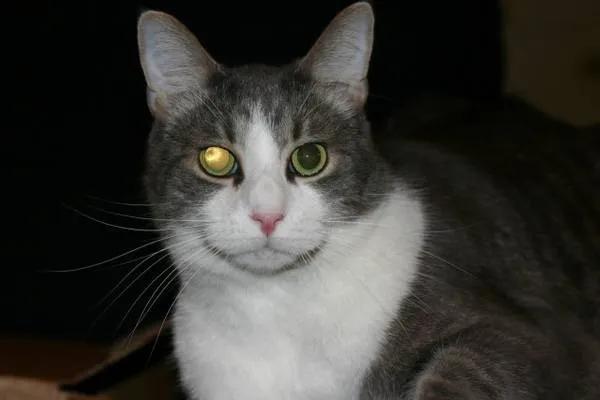
A cat can also get this condition from a fight or if the cat is diabetic. Treatment is by surgery, removal of the lens. Drops can also be used in the initial stages of the disease, but they only slow the process down a bit, not get rid of the clouding.
Ptosis in cats
Ptosis is a condition in which the upper eyelid droops.
Ptosis in cats](../../../assets/bolezni-glaz-u-koshek-7.jpg)
There are several causes of the disease: trauma, chemical and thermal burns, viruses, and microbes. Treatment is surgical.